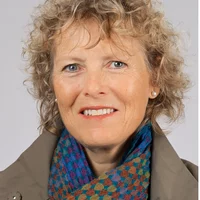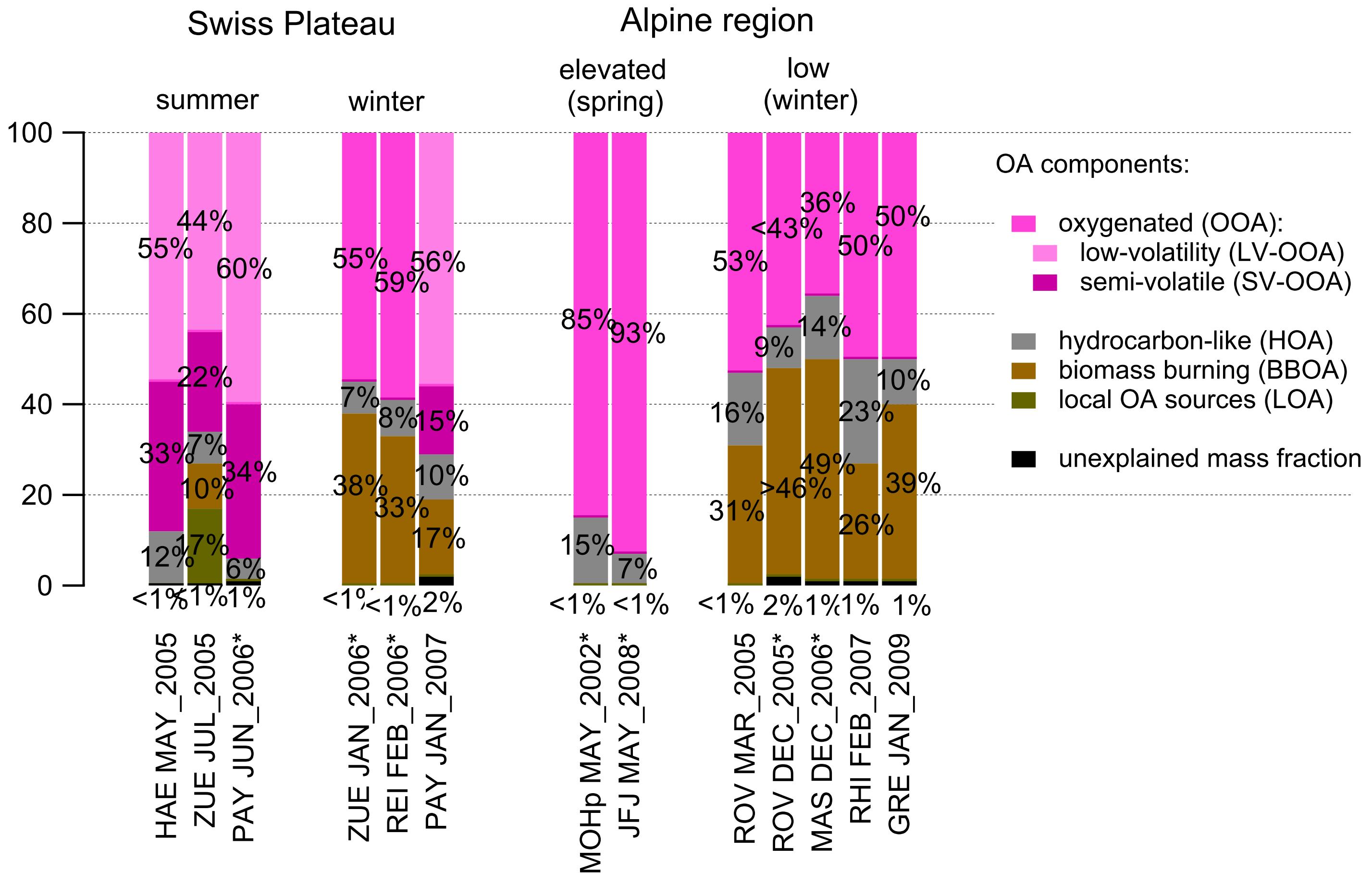Scope of project
Aerosol mass spectrometry was used to measure the non-refractory chemical composition of particulate matter of PM1. From Zurich 2011, a new lens allowing for measurements above 2.5 micrometers was used. Source apportionment techniques are developed to quantify the sources of organic aerosol in Switzerland.
Field campaigns
- Roveredo, 1 - 15 Mar 2005
- Zurich, 14 Jul - 4 Aug 2005
- Roveredo, 15 Nov - 15 Dec 2005
- Zurich, 6 - 25 Jan 2006
- Härkingen, 12 - 30 May 2005
Sources/components of organic mass (PM1) at various stations in Central Europe
- Reiden, 27 Jan - 13 Feb 2006
- Payerne, 31 May - 3 Jul 2006
- Massongex, 23 Nov - 17 Dec 2006
- Payerne, 12 Jan - 17 Feb 2007
- Rhine Valley (mobile lab), 16 - 22 Feb 2007 / 8 - 13 Feb 2008
- Zurich (mobile lab), 27 Nov 2007 - 16 Dec 2008 (10 days)
- Jungfraujoch, 30 Apr - 29 May 2008
- Payerne, 17 Sep - 16 Oct 2008
- Zurich, 1 - 18 Dec 2008
- Payerne, 17 Feb - 26 Mar 2009
- Zurich, 1 - 15 Apr 2011
Key findings
- Wood burning was found to be a major source in the Alpine valley in Roveredo (Alfarra et al., 2007) which could be confirmed by Aethalometer and 14C measurements
- Mass fragments 60, 73, 137 were identified as possible markers of wood burning (Alfarra et al., 2007)
- First Positive Matrix Factorization application on AMS data (Lanz et al., 2007)
- Distinction of at least 5 factors including OOA1 (Low Volatility oxygenated organic aerosol(LV-OOA)), OOA2 (Semi-volatile OOA (SV-OOA), HOA (hydrocarbon-like organic aerosol), WBOA (wood burning organic aerosol), COA (charbroiling/cooking aerosol) in Zurich summer (Lanz et al., 2007)
- First Multi-linear engine (ME-2) application on AMS data (Lanz et al., 2008)
- Most OOA is non-fossil in winter (Lanz et al., 2008)
- Contribution of woodburning much more important than traffic in Zurich in winter (Lanz et al., 2008)
- In nearly all campaigns, OOA is the dominating contribution to organic mass (36-94%), wood burning accounted for 17-49% in winter, HOA contributed only 6-16% (Lanz et al., 2010)
- In 13 different campaigns, organics contribute 36-81% to non-refractory PM1, ammonium 5-15%, nitrate 8-36%, sulfate 3-26%, and chloride (0-5%)
- In 13 different campaigns, organics contribute 36-81% to non-refractory PM1, ammonium 5-15%, nitrate 8-36%, sulfate 3-26%, and chloride (0-5%)
- At low altitude in the Swiss Plateau, the main differences between summer and winter were the high organic fraction in summer (62-68%) versus 36-40% in winter, whereas nitrate contributed more in winter (31-36%) than in summer (8-13%)
- Mobile measurements on the road indicate higher contributions of traffic than at background locations (Mohr et al., 2011)
- First combination of aerosol mass spectrometer measurements with high-time resolution elemental composition measurements (using RDI and s-XRF) allowing for a more complete source apportionment of PM1 and the coarse fractions PM10-PM2.5 and PM2.5 and PM1 (Richard et al., 2011)
Publications
Journal Articles
Identification of the mass spectral signature of organic aerosols from wood burning emissions.Alfarra, M. R., A. S. H. Prevot, S. Szidat, J. Sandradewi, S. Weimer, D. Schreiber, M. Mohr, and U. Baltensperger, 2007
Environmental Science and Technology, 41, 5770-5777.
Source apportionment of submicron organic aerosols at an urban site by factor analytical modelling of aerosol mass spectra.
Lanz, V. A., M. R. Alfarra, U. Baltensperger, B. Buchmann, C. Hueglin, and A. S. H. Prevot, 2007
Atmos. Chem. Phys., 7, 1503-1522.
Source attribution of submicron organic aerosols during wintertime inversions by advanced factor analysis of aerosol mass spectra.
Lanz, V. A., M. R. Alfarra, U. Baltensperger, B. Buchmann, C. Hueglin, S. Szidat, M. N. Wehrli, L. Wacker, S. Weimer, A. Caseiro, H. Puxbaum, and A. S. H. Prevot, 2008
Environmental Science and Technology, 42, 214-220.
Characterization of aerosol chemical composition with aerosol mass spectrometry in Central Europe: an overview.
Lanz, V. A., A. S. H. Prévôt, M. R. Alfarra, S. Weimer, C. Mohr, P. F. DeCarlo, M. F. D. Gianini, C. Hueglin, J. Schneider, O. Favez, B. D'Anna, C. George, and U. Baltensperger, 2010
Atmos. Chem. Phys., 10, 10453-10471.
Spatial variation of chemical composition and sources of submicron aerosol in Zurich during wintertime using mobile aerosol mass spectrometer data.
Mohr, C., R. Richter, P. F. DeCarlo, A. S. H. Prevot, and U. Baltensperger, 2011
Atmospheric Chemistry and Physics, 11, 7465-7482.
DOI: 10.5194/acp-11-7465-2011
Source apportionment of size and time resolved trace elements and organic aerosols from an urban courtyard site in Switzerland.
Richard, A., M. F. D. Gianini, C. Mohr, M. Furger, N. Bukowiecki, M. C. Minguillon, P. Lienemann, U. Flechsig, K. Appel, P. F. DeCarlo, M. F. Heringa, R. Chirico, U. Baltensperger, and A. S. H. Prevot, 2011
Atmospheric Chemistry and Physics, 11, 8945-8963.
DOI: 10.5194/acp-11-8945-2011
Thesis
Atmospheric transformation and source attribution of reactive organic compoundsLanz Valentin, 2008 (Affiliation: Empa)



